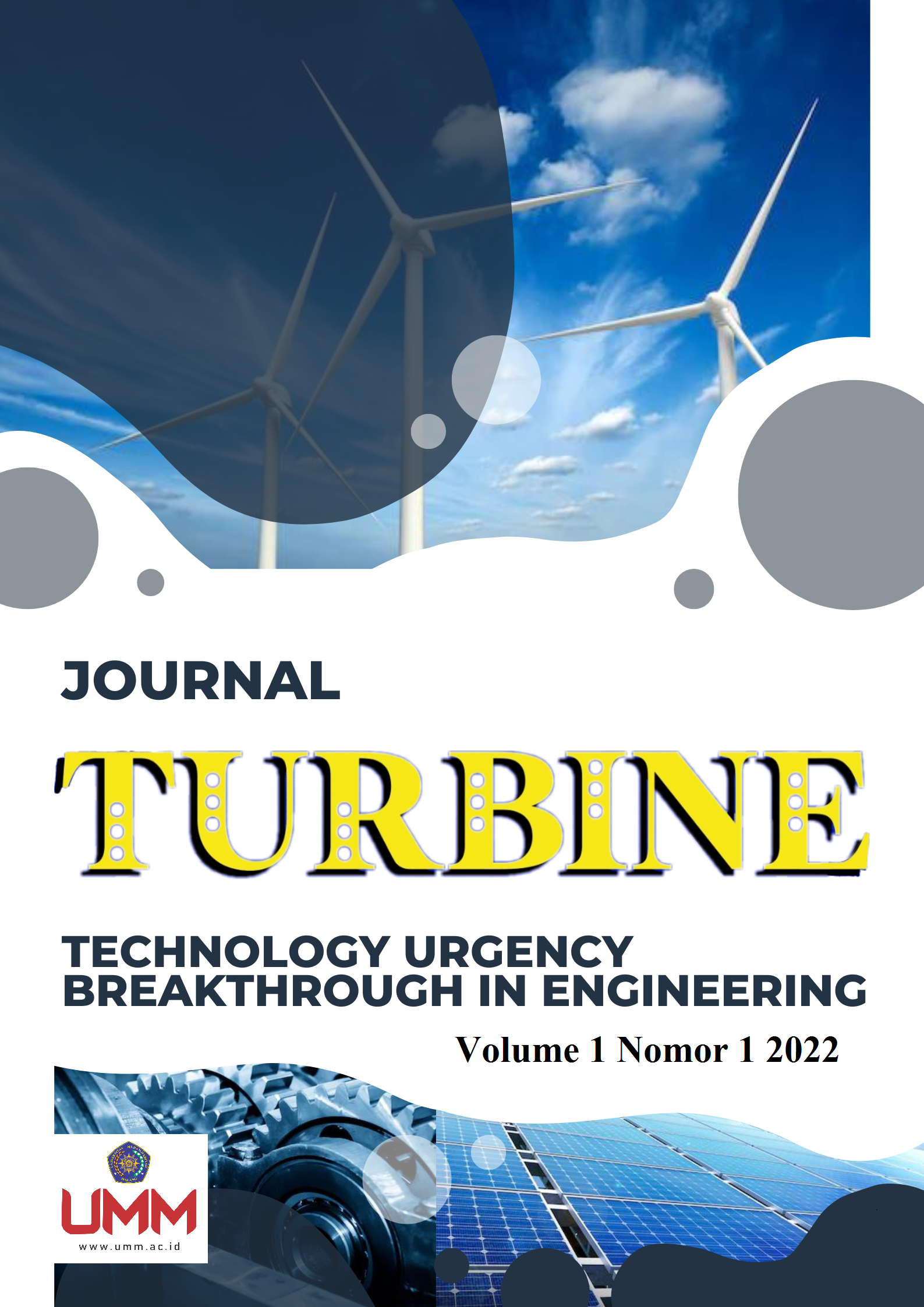Pengaruh Fraksi Massa dan Bentuk serat Pisang Abaka Terhadap Kekuatan Tarik Pada Proses Pembuatan Komposit
Keywords:
serat abaca, komposit,, , fraksi berat, bentuk serat, kekuatan tarik.Abstract
Abstracts
In matrix resin-reinforced fiber composites the contribution of high tensile strength, strength and stiffness properties increases at the end, while minimizing weight. Various reasons including its potential to replace plastics known as synthetic fibers at low cost but have continued to increase interest in natural fiber composites [3]. Natural fibers have a sustainable behavior that can be biodegradable, this has several advantages such as easy processing, renewable, affordable cost, high disposability, low density, and can be recycled [5][6]. In this study, the type of experimental research or True Experiment Research was carried out, because the required data can only be obtained from an experiment. In the process of making composite specimens using variations in the mass fraction and fiber shape of 10%, 15%, 20%, and 25% of the tensile strength with the vacuum infusion method. The highest tensile strength value was obtained for the 25% short fiber mass fraction variation, namely 94,264 Mpa and the lowest value for the 10% short fiber mass fraction variation, 13,338 Mpa. It can be concluded that the influence of the weight fraction and the shape of the abaca fiber has an effect on the tensile strength results.
Kata Kunci: abaca fiber, composite, weight fraction, fiber shape, tensile strength.
Abstrak
Dalam komposit serat yang diperkuat resin matriks kontribusi kekuatan tarik tinggi, kekuatan dan sifat kekakuan meningkat pada akhirnya, sambil meminimalkan berat. Berbagai alasan termasuk potensinya untuk menggantikan plastik yang dikenal sebagai serat sintetis dengan biaya rendah tetapi terus meningkatkan minat terhadap komposit serat alam [3]. Serat alam memiliki perilaku berkelanjutan yaitu dapat terurai secara hayati, hal ini memiliki beberapa keunggulan seperti pengolahan yang mudah, terbarukan, biaya terjangkau, daya pakai tinggi, kepadatan rendah, dan dapat didaur ulang [5][6]. Pada penelitian ini dilakukan jenis penelitian eksperimen atau True Experiment Research, karena data yang dibutuhkan hanya dapat diperoleh dari eksperimen. Pada proses pembuatan spesimen komposit menggunakan variasi fraksi massa dan bentuk serat 10%, 15%, 20%, dan 25% dari kekuatan tarik dengan metode vacuum infusion. Nilai kuat tarik tertinggi diperoleh pada variasi fraksi massa serat pendek 25% yaitu 94,264 Mpa dan nilai kekuatan tarik terendah pada variasi fraksi massa serat pendek 10% yaitu 13,338 Mpa. Dapat disimpulkan bahwa pengaruh fraksi berat dan bentuk serat abaka berpengaruh terhadap hasil kuat tarik.
Kata Kunci: serat abaca, komposit, fraksi berat, bentuk serat, kekuatan tarik.
Downloads
References
R. N. Ichsan and M. A. Irfa’i., “Pengaruh Susunan Lamina Komposit Berpenguat Serat EGlass Dan Serat Carbon Terhadap Kekuatan Tarik Dengan Matrik Polyester,” J. Tek.
Mesin, vol. 03, no. 3, pp. 32–39, 2015.
W. D. Callister Jr and D. G. Rethwisch, Materials Science and Engineering - An Introduction
th Edition. 2018.
A. Asroni and S. Dri Handono, “Kaji Eksperimen Variasi Jenis Serat Batang Pisang Untuk
Bahan Komposit Terhadap Kekuatan Mekanik,” Turbo J. Progr. Stud. Tek. Mesin, vol. 7,
no. 2, pp. 214–222, 2018, doi: 10.24127/trb.v7i2.764.
K. Srinivas, A. Lakshumu Naidu, and M. V. A. Raju Bahubalendruni, “A review on chemical
and mechanical properties of natural fiber reinforced polymer composites,” Int. J.
Performability Eng., vol. 13, no. 2, pp. 189–200, 2017, doi:
23940/ijpe.17.02.p8.189200.
F. Hendriwan and H. Harry, “Pengaruh Orientasi Serat pada Komposit Resin Polyester/
Serat Daun Nenas Terhadap Kekuatan Tarik,” J. Tek. Mesin, vol. 1, no. 1, pp. 46–52,
M. Puttegowda, H. Pulikkalparambil, and S. M. Rangappa, “Trends and Developments in
Natural Fiber Composites,” Appl. Sci. Eng. Prog., vol. 14, no. 4, pp. 543–552, 2021, doi:
14416/j.asep.2021.06.006.
S. Yogeshwaran, L. Natrayan, G. Udhayakumar, G. Godwin, and L. Yuvaraj, “Effect of waste
tyre particles reinforcement on mechanical properties of jute and abaca fiber - Epoxy
hybrid composites with pre-treatment,” Mater. Today Proc., vol. 37, no. Part 2, pp. 1377–
, 2020, doi: 10.1016/j.matpr.2020.06.584.
S. Karyati, L. Herawati, and S. P. Ganefati, “Pengaruh Penambahan Limbah Pelepah Pisang
Sebagai Komponen Daur Ulang Kertas,” J. Kesehat. Lingkung., vol. 5, no. 1, pp. 8–15,
A. K. Sinha, H. K. Narang, and S. Bhattacharya, “Tensile Strength of Abaca Epoxy Laminated
Composites,” Mater. Today Proc., vol. 5, no. 14, pp. 27861–27864, 2018, doi:
1016/j.matpr.2018.10.024.
B. Kumar Singh, U. Kumar Komal, Y. Singh, S. Singh Banwait, and I. Singh, “Development
of banana fiber reinforced composites from plastic waste,” Mater. Today Proc., vol. 44, pp.
–2198, 2021, doi: 10.1016/j.matpr.2020.12.352.
H. Hermansyah and S. Mulyanto, “Analisa Kekuatan Tarik dan Bentuk Patahan Komposit
Serat Sabuk Kelapa Bermatriks Epoxy terhadap Variasi Fraksi Volume Serat,” vol. 6, no.
, pp. 2–7, 2018.
M. B. E. H, H. Arbiantara, D. Dwilaksana, and H. D. Pembahasan, “Pengaruh Variasi Fraksi
Berat dan Panjang Serat Komposit Pelepah Kelapa dengan Matriks Polypropylene
terhadap Kekuatan Tarik pada Proses Injection Moulding Coconut Midrib with The
Polypropylene Matrix Against Tensile Strength on The Injection Moulding Pro”.
Downloads
Published
Issue
Section
License
Copyright (c) 2023 Mulyadi Halim

This work is licensed under a Creative Commons Attribution-NonCommercial 4.0 International License.




